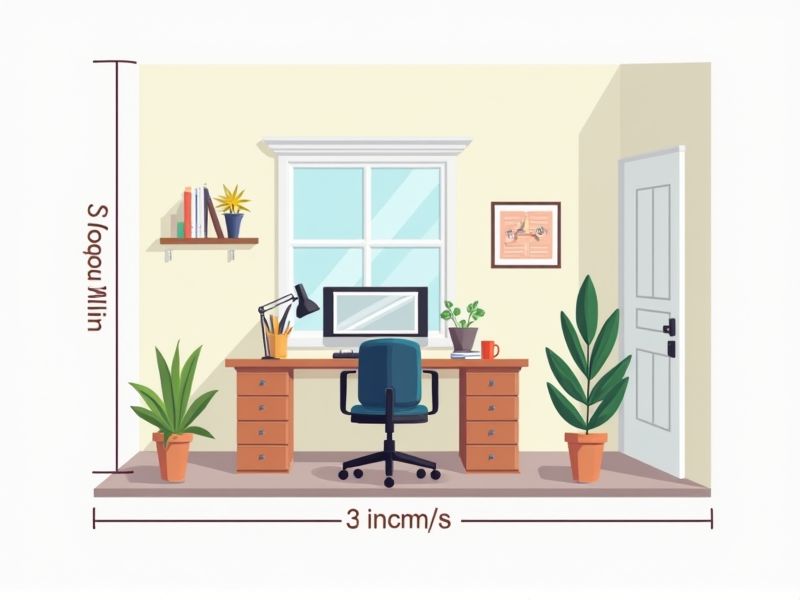
When designing a home office, it's useful to know standard room dimensions to maximize both comfort and productivity. Typically, a dedicated home office ranges from 50 to 150 square feet, with popular layouts like 8x10 feet or 10x12 feet providing enough space for a desk, chair, and storage. When planning your setup, ensure there's adequate room to move around and that furniture placement allows easy access to outlets and natural light. Tailoring the room dimensions to fit your needs--such as extra space for bookshelves or dual monitors--will help create an efficient, inviting workspace.
Desk Height
Ergonomically, desk height is crucial in a home office environment to promote comfort and productivity. The ideal desk height typically ranges from 28 to 30 inches for seated work, accommodating most individuals. For those who prefer standing, adjustable desks can vary between 38 to 48 inches to ensure proper posture. Choosing the right desk height can significantly reduce the risk of discomfort, enabling you to maintain focus for longer periods.
Office Chair Size
The size of an office chair greatly influences comfort and productivity, with ergonomic designs typically ranging from 16 to 21 inches in seat height. A well-fitted office chair should allow your feet to rest flat on the floor and your knees to maintain a 90-degree angle. Choosing a chair with a seat width of 20 to 22 inches accommodates various body types, enhancing support during extended work hours. Remember, investing in a suitable chair can improve posture and reduce the risk of musculoskeletal issues.
Bookshelf Dimensions
The ideal bookshelf dimensions for a home office typically range from 72 to 84 inches in height and 30 to 48 inches in width, accommodating various books and office supplies. When considering depth, a measurement of 12 to 16 inches is optimal for standard book sizes while ensuring stability. You should also account for adjustable shelves to effectively store both small and large items, enhancing versatility. A well-organized bookshelf can significantly improve productivity and aesthetic appeal, making it an essential component of your home office setup.
Filing Cabinet Size
When selecting a filing cabinet for your home office, consider the dimensions that best fit your space and storage needs. Standard filing cabinet sizes typically include vertical models measuring 18 inches wide by 24 inches deep, while lateral cabinets can extend up to 36 inches wide. Ensure your cabinet has at least four drawers to accommodate a substantial volume of documents, as this allows for better organization and accessibility. Selecting a cabinet finished with durable materials, such as steel or high-quality laminate, can enhance longevity and aesthetics in your workspace.
Room Size
The ideal home office should have a minimum room size of 100 square feet to ensure adequate space for furniture and movement. A dedicated area allows for better focus and productivity, reducing distractions commonly found in shared spaces. Consider incorporating ergonomic furniture, as positions that promote comfort can increase work efficiency by up to 30%. Creating a quiet environment with soundproofing features can further enhance your concentration, making your home office a productive sanctuary.
Monitor Height
The ideal monitor height for a home office setup is typically at eye level, which means the top of the monitor screen should be approximately 20 to 30 inches from your eyes. This arrangement helps maintain a neutral neck position, reducing strain and promoting comfort during long hours of work. Ergonomically, you should use an adjustable monitor stand or riser to achieve this alignment, with a monitor tilt of about 10 to 20 degrees for the best visual experience. For optimal productivity, consider that the average worker spends around 8 hours a day in front of the screen, making proper height adjustment crucial for sustaining focus and preventing fatigue.
Legroom Clearance
When designing a home office, ensuring at least 24 inches of legroom clearance under your desk is essential for comfort and productivity. This space allows you to move freely, enhancing your posture and reducing fatigue during long working hours. Ergonomic chairs typically require 17 to 20 inches of adjustable height, which complements optimal legroom for a healthy seating position. Investing in a desk with a height of 28 to 30 inches ensures ample clearance while maintaining an ergonomic workspace tailored to your needs.
Keyboard Tray Space
A well-designed home office should allocate at least 20 to 30 inches of keyboard tray space to ensure ergonomic comfort while working. This space allows for proper positioning of your hands, reducing the risk of repetitive strain injuries. If you're considering a sit-stand desk, ensuring that the keyboard tray can adjust between 24 to 34 inches in height can enhance your work experience. Investing in an adjustable keyboard tray can significantly improve your productivity by creating a more comfortable and efficient workspace.
Lighting Placement
Effective home office lighting hinges on strategic placement to enhance productivity and reduce eye strain. Position your desk near windows to utilize natural light, which can increase mood and energy levels by up to 15%. Utilize a combination of ambient, task, and accent lighting; a desk lamp with adjustable brightness can provide direct light for focused tasks, especially during evening hours. Aim for a color temperature of 4000-5000 Kelvin for optimal clarity and comfort when working.
Storage Cabinet Dimensions
When designing a home office, the standard dimensions for storage cabinets typically range from 30 to 72 inches in height and 24 to 36 inches in width, ensuring compatibility with various room sizes. Depth commonly spans 16 to 24 inches, allowing ample space for files, books, and office supplies while maintaining a compact footprint. Choosing cabinets with adjustable shelves can enhance their functionality, accommodating both small items and larger binders, with shelf spacing often ranging from 12 to 15 inches apart. For optimal organization, consider cabinets equipped with drawer systems, as these can improve accessibility and keep your workspace clutter-free.
